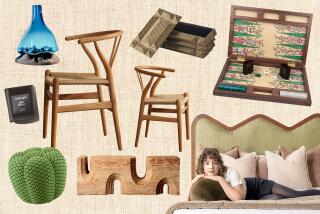INTERIORS : For Goof-Proof Decorating, Take a Tip--or Three--From the Pros
- Share via
Formula decorating may lack originality, but it gets high marks for ease and good results.
“If you want to make a room look as if a designer did it, there’s a simple formula,” says decorator Trudy Dujardin. “It involves choosing several coordinating fabrics.”
Three, to be exact. And fabric books at your local upholstery shop are chock full of mix-and-match swatches.
The main fabric, she says, the one you’ll use the most of, can be a solid, a print or a stripe. Many people pick a floral. Use it on the largest piece of upholstery, usually a sofa. Repeat the fabric as a window treatment and in one other place, a skirted table or an easy chair, for example.
If your focus is a floral, make the second fabric a stripe or a small geometric print in a color that goes well with the floral. Suitable colors are those on the color wheel that are next to or opposite the main color of the floral. For example, next to yellow are orange and red. Opposite it are blues and greens. Either would work. Use this second fabric on another piece of upholstery or on all the throw pillows.
Now select the third fabric. If you have used patterned materials up to now, choose a solid. Use it for an ottoman or a table cover, or if you want, another couple of pillows. If your main color is a solid, reverse the order, choosing a stripe and a floral as the second and third fabrics.
If you want to emphasize objects in the room--art, collectibles and ornamental rugs, for example--stick to solid fabrics. Consider a sofa slipcovered in blue, and use the same solid at the windows. Upholstery welting and window covering trim could be a strong contrast such as yellow, red or white. A third element can be either a solid or a stripe or small print combining the two colors. Use it for throw cushions, table cover or to cover an accent chair.
For a luxurious result, select a heavy fabric such as velvet, damask or a heavyweight cotton for sofa and chairs. Also use a substantial fabric at the windows, Dujardin says.
Taking ideas from wallpaper collections is another option open to decorating duffers.
Sample wallpaper books often contain wall covering and fabric that are color and design coordinated. The books have photos and illustrations of schemes combining several patterns.
“The easiest thing for a beginner to do is to choose an appealing room illustrated in a wallpaper book and copy it,” says Barbara Brower, marketing product manager at Seabrook Wallcoverings of Memphis.
She says not to worry that the room will look like the book. It won’t. “All the accessories will be different, and the room is different,” she says.
If you don’t want to copy exactly what you see, choose the patterns in a different color scheme, or choose slightly different patterns. Or use one or more of the elements in a different way, such as putting the border at chair-rail height rather than at the ceiling.
Some wallpaper books are organized by color rather than by pattern. These are the simplest for novices to glean for decorating ideas. Not only will the patterns pictured in a room setting work well, but almost all the patterns in that particular color group will work together.
When books are organized by design, quite often you can mix designs so long as they are all in the same color family.
“Color can really tie almost all unrelated elements together, provided the designs aren’t from radically different periods,” Brower says.
Stripes and small prints are safe, working with almost any room and almost any furnishings. But it’s more interesting to take a bold approach.
“Choose something to be the star of the show,” Brower says. “This doesn’t have to occupy the largest amount of space. It can be a border.”
Borders can be especially adventurous. They’re a small portion of the wall and can be easily taped up temporarily to judge the effect.
A final caveat: Brower says if you use a wallpaper book as your source for ideas, go an additional step.
“Buy a single roll or obtain a large sample of the main wallpapers and consider ordering a yard of the coordinating fabric,” she says. “Bring them home and put them up and observe them at different times of the day and get the opinions of the others in the family.”


